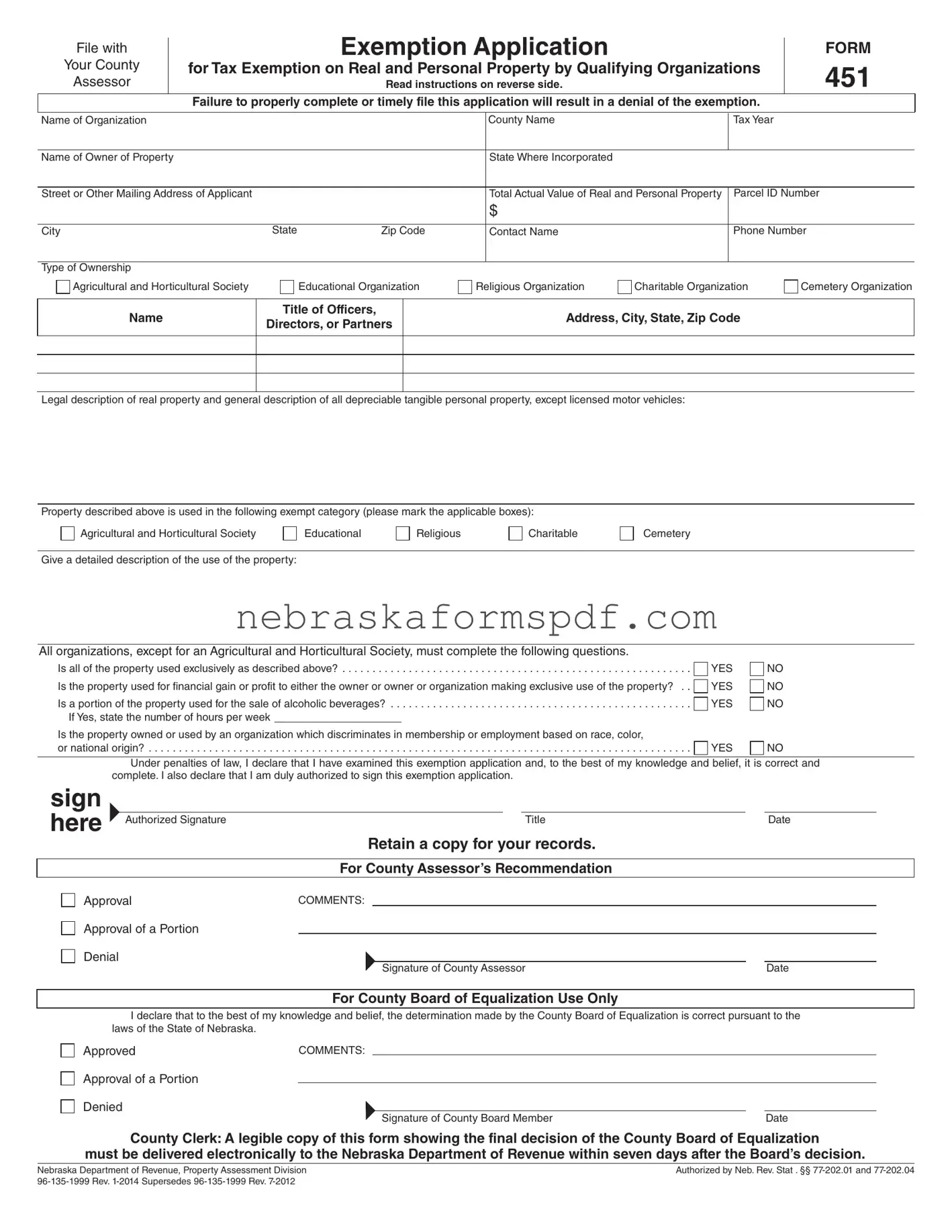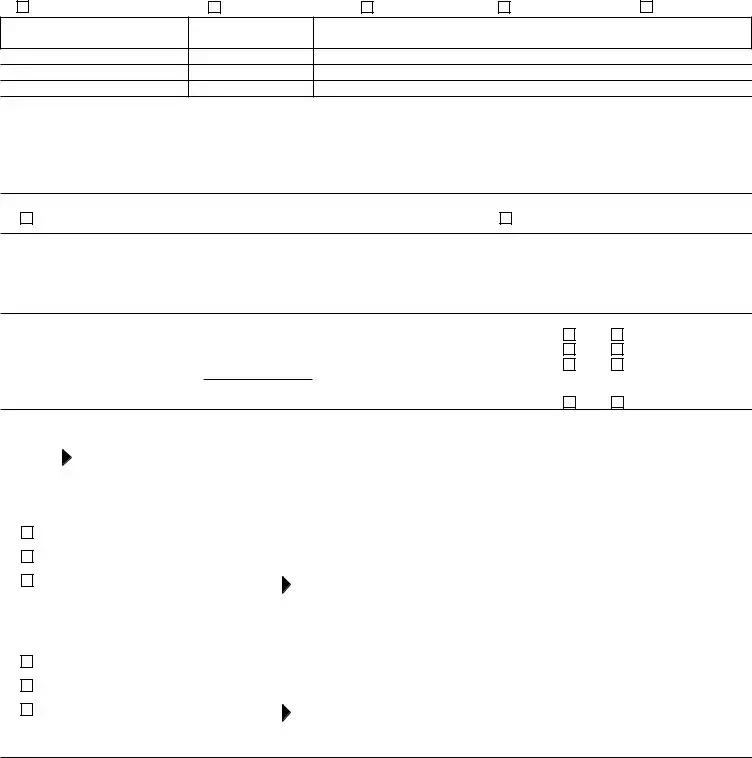File with |
|
|
|
Exemption Application |
|
|
FORM |
Your County |
|
for Tax Exemption on Real and Personal Property by Qualifying Organizations |
|
451 |
Assessor |
|
|
|
|
|
Read instructions on reverse side. |
|
|
|
|
Failure to properly complete or timely file this application will result in a denial of the exemption. |
|
|
|
|
|
|
|
|
|
|
Name of Organization |
|
|
|
County Name |
Tax Year |
|
|
|
|
|
|
|
|
|
Name of Owner of Property |
|
|
|
State Where Incorporated |
|
|
|
|
|
|
|
|
|
Street or Other Mailing Address of Applicant |
|
|
Total Actual Value of Real and Personal Property |
Parcel ID Number |
|
|
|
|
|
|
$ |
|
|
|
|
|
|
|
|
|
|
City |
|
State |
Zip Code |
Contact Name |
Phone Number |
|
|
|
|
|
|
|
|
|
|
Type of Ownership
Agricultural and Horticultural Society
Title of Officers,
Directors, or Partners
Address, City, State, Zip Code
Legal description of real property and general description of all depreciable tangible personal property, except licensed motor vehicles:
Property described above is used in the following exempt category (please mark the applicable boxes):
Agricultural and Horticultural Society |
|
Educational |
|
Religious |
|
Charitable |
Give a detailed description of the use of the property:
All organizations, except for an Agricultural and Horticultural Society, must complete the following questions.
Is all of the property used exclusively as described above? . . . . . . . . . . . . . . . . . . . . . . . . . . . . . . . . . . . . . . . . . . . . . . . . . . . . . . . . . .
Is the property used for financial gain or profit to either the owner or owner or organization making exclusive use of the property? . .
Is a portion of the property used for the sale of alcoholic beverages? . . . . . . . . . . . . . . . . . . . . . . . . . . . . . . . . . . . . . . . . . . . . . . . . . .
If Yes, state the number of hours per week
Is the property owned or used by an organization which discriminates in membership or employment based on race, color,
or national origin? . . . . . . . . . . . . . . . . . . . . . . . . . . . . . . . . . . . . . . . . . . . . . . . . . . . . . . . . . . . . . . . . . . . . . . . . . . . . . . . . . . . . . . . . . .
Under penalties of law, I declare that I have examined this exemption application and, to the best of my knowledge and belief, it is correct and complete. I also declare that I am duly authorized to sign this exemption application.
sign
|
|
|
|
|
|
|
|
|
|
|
here Authorized Signature |
|
|
|
|
Title |
|
Date |
|
|
Retain a copy for your records. |
|
|
|
|
|
|
|
|
|
|
|
|
|
|
|
|
|
For County Assessor’s Recommendation |
|
|
|
|
Approval |
COMMENTS: |
|
|
|
|
|
|
|
|
Approval of a Portion |
|
|
|
|
|
|
|
|
|
Denial |
|
|
|
|
|
|
|
|
|
|
|
|
|
Signature of County Assessor |
|
Date |
|
|
|
|
|
|
|
|
|
|
|
|
|
For County Board of Equalization Use Only |
|
|
|
|
|
|
|
|
|
|
|
|
|
|
|
|
I declare that to the best of my knowledge and belief, the determination made by the County Board of Equalization is correct pursuant to the |
|
laws of the State of Nebraska. |
|
|
|
|
|
|
|
|
|
Approved |
COMMENTS: |
|
|
|
|
|
|
|
|
|
|
|
|
|
|
|
|
Approval of a Portion |
|
|
|
|
|
|
|
|
|
|
|
|
|
|
|
|
|
|
Denied |
|
|
|
|
|
|
|
|
|
|
|
Signature of County Board Member |
|
Date |
|
|
|
|
|
County Clerk: A legible copy of this form showing the final decision of the County Board of Equalization
must be delivered electronically to the Nebraska Department of Revenue within seven days after the Board’s decision.
Nebraska Department of Revenue, Property Assessment Division |
Authorized by Neb. Rev. Stat . §§ 77-202.01 and 77-202.04 |
96-135-1999 Rev. 1-2014 Supersedes 96-135-1999 Rev. 7-2012 |
|
Instructions
Who May File. An organization that owns real or depreciable tangible personal property, except licensed motor vehicles, and is seeking a property tax exemption, must ile an Exemption Application for Tax Exemption on Real and Personal Property by Qualifying Organizations, Form 451, if:
1.The property is owned by and used exclusively for agricultural and horticultural societies; or
2.The property is:
a.Owned by educational, religious, charitable, or cemetery organizations, or any organization for the exclusive beneit of any educational, religious, charitable, or cemetery organization;
b.Used exclusively for educational, religious, charitable, or cemetery purposes;
c.Not owned or used for inancial gain or proit to either the owner or user;
d.Not used for the sale of alcoholic beverages for more than 20 hours per week; AND
e.Not owned or used by an organization which discriminates in membership or employment based on race, color, or national origin.
An organization must ile a Form 451 if new property is acquired, or if the property is converted to exempt use.
When and Where to File. The Form 451 must be iled on or before the December 31 immediately preceding the year for which the exemption is sought, with the county assessor of the county where the property is subject to tax.
Late Filings/Waivers. If an organization fails to ile a Form 451 on or before December 31, it may ile a Form 451 on or before June 30 with the county assessor. The organization or society must also ile a written request with the county board of equalization for a waiver, so that the county assessor may consider the application for exemption. The county board of equalization may grant the waiver upon inding that good cause exists for the failure to make application on or before December 31.
If the waiver is granted, the county assessor will examine the application and recommend to the county board of equalization whether the real property or tangible personal property should be taxable or exempt. The county assessor must assess a penalty against the organization in the amount of 10% of the tax that would have been assessed had the waiver been denied or $100, whichever is less, for each calendar month or fraction thereof for which the iling of the exemption application missed the December 31 deadline. The penalty may not be waived.
Property Acquired or Converted to Exempt Use. If property is acquired or converted to exempt use after January 1, the organization may ile an application for exemption on or before July 1 of the year the property was acquired or converted. If an organization, between July 1 and levy date (October 15), purchases property that has been granted a tax exemption, and the property continues to be qualiied for exemption, the purchasing organization must ile an application for exemption on or before November 15.
Taxable property acquired or converted after July 1 is not eligible for exemption that year. If an application is iled, it will be considered an application for exemption for the next year.
Intervening Years.After an exemption has been approved, a new application must be iled for every year evenly divisible by four. For the intervening years (those years not evenly divisible by four), the Statement of Reafirmation of Tax Exemption, Form 451A , must be iled on or before the December 31 immediately preceding the year for which the exemption is sought, except for real property of cemeteries.
Cemetery Organizations. Any real property exemption granted to a cemetery organization will remain in effect without reapplication, unless disqualiied by change of ownership or use. On or before August 1, the county assessor must annually review the ownership and use of all cemetery real property and report this review to the county board of equalization.
Appeal Procedures. In the event of disapproval of this application by the county board of equalization, an appeal may be iled with the Tax Equalization and Review Commission within 30 days of the inal decision.
Specific Instructions. Property tax exemptions are strictly construed, and it is the responsibility of the applicant to prove the property qualiies for an exemption.
If the property is used for more than one type of use, mark the appropriate blocks and give the approximate percentage of use under the classiication. Describe in detail the use of the property for which an exemption is sought. Explain any circumstances when the property may be used for taxable purposes. If additional space is needed, use a separate sheet of paper and attach a copy to each copy of this form.
The completed Form 451 must be retained by the county clerk after the county board of equalization action, with a legible copy forwarded electronically to the Department within seven days of the board’s decision. The county assessor may make copies for the county’s records.

